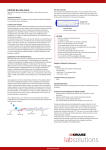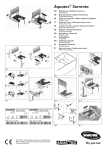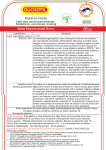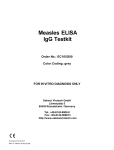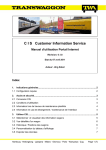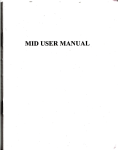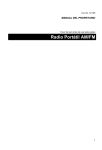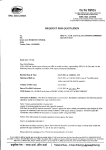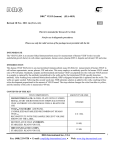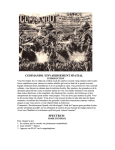Download labsolutions
Transcript
KRUUSE Ehrlichia Quick The Test Cassette Rapid test for detection of Ehrlichia antibodies in whole blood, serum or plasma. Instruction Manual The test strip is located behind the plastic cover. The sample well is on the right side. The reaction field is located in the middle of the test cassette. The test and the control region are located in the reaction field. The labelling above the reaction field shows the test and control region. KRUUSE Ehrlichia Quick is used for the rapid assay detection of specific antibodies against Ehrlichia canis in whole blood, serum or plasma of dogs. Sample well for blood sample Ehrlichia canis Canine monocytic ehrlichiosis (CME) is a vector-borne disease transmitted by ticks. The pathogen Ehrlichia canis (E. canis) is a Rikettsiaceae (gram-negative obligate intracellular bacteria) and is transmitted by the brown dog tick Rhipicephalus sanguineus (R. sanguineus). The disease occurs in dogs, especially in southern Europe. After an incubation period of 8 to 20 days, the course of the disease is divided into three phases. In the first acute phase, the clinical symptoms are not pathognomonic and rather mild with nonspecific clinical signs such as fatigue, fever, swollen lymph nodes, anorexia, and dyspnoea. The pathogen infects lymphocytes and monocytes. The second subclinical phase may last from several months to years and is characterized by pathogen persistence, with an increased antibody production. These dogs appear clinically healthy. The third phase is chronic CME characterized by complex clinical symptoms resulting from different organ manifestations of the pathogen and persistent antibody production. The consequences can be immune complex-mediated glomerulopathies, arthropathies, splenomegaly, or neurological symptoms. Nonspecific symptoms such as fever, anorexia and lethargy also continue. A serological test for antibodies against Ehrlichia canis should always be interpreted in conjunction with the current clinical symptoms. The detection of antibodies is possible after the seventh day of infection, and indicates a past contact with the pathogen. However, the seroconversion can sometimes take up to four weeks. But even dogs with an infection stopped at an early stage may have low antibody titers for several months and are serologically negative. Here regular examination is advised. With the KRUUSE Ehrlichia Quick veterinarians have a useful tool for the accurate and rapid detection of an infection with Ehrlichia canis at an early stage so correct treatment and prevention can be implemented. Test Principle KRUUSE Ehrlichia Quick rapid assay is a sandwich immunoassay which was developed for professional use by veterinarians. The assay uses specific antibodies which capture Ehrlichia canis antibodies from the sample and thus visualise the agent. KRUUSE Ehrlichia Quick is a highly sensitive immunoassay and comes in a handy test cassette, in which a membrane is included. Explanation of the Testing Process KRUUSE Ehrlichia Quick test consists of a sample pad, a conjugate pad, which contains Ehrlichia canis specific goldlabeled antigens, a membrane precoated with Ehrlichia canis specific capture antigens immobilized in the test line region and control antibodies immobilized in the control line region and finally a wicking pad, which takes up the fluid applied to the test cassette. Reaction field test and control region CAUTION • • • • • • • • • • • • Only for veterinary and professional use For single use only Use the test cassette within 10 minutes ofopening Please use an appropriate amount of sample Do not apply sample solution to the reaction field Avoid cross reactions by using a new sample tube for each sample Do not touch the reaction field Use only the original buffer provided in the kit Sample material could be infectious. Be careful with waste disposal Do not use cassettes after the expiry date Do not use the test if the packaging is damaged Consider the test results as invalid after indicated time Reagents, Materials, Instruments I. Contents • 5 test cassettes with pipette and drying bag • 5 sample tubes • 1 bottle with 2.5 ml reagent buffer • 1 instruction manual II. Additional Necessary Equipment •Timer Sample Preparation KRUUSE Ehrlichia Quick is developed for examinations of whole blood, serum and plasma. ATTENTION: Samples and other materials should be handled as infectious materials. General recommendations for blood samples • Separate serum or plasma from blood as soon as possible to avoid haemolysis • Heparin or EDTA blood can be used for the plasma extraction • Use only clear, non-haemolyzed specimens • Use of whole blood my decrease the sensitivity of the test result Upon application onto the test strip Ehrlichia canis antibodies in the sample material react with the gold-labelled antigens in the conjugate pad. The fluid then migrates up the strip by capillary action. In the test line region the Ehrlichia canis antibody-gold marked antigen complexes are captured by the immobilised capture reagents so that a red line is generated. The presence of a red line in the test line region indicates a positive result. If the sample does not contain Ehrlichia canis antibodies, no line will form in the test line region. Additionally, a red line must form in the control line region, independently of the presence of Ehrlichia canis antibodies in the specimen. The control line serves as an internal control and indicates that sufficient sample fluid has been applied to the test strip and that proper wicking of the membrane has occurred. Testing should be performed immediately after sample collection. Do not leave the specimens at room temperature for prolonged periods. Serum and plasma specimens may be stored at 2-8° C for up to 3 days. For long-term storage, specimens should be kept below -20°C. Whole blood collected by venipuncture should be stored at 2-8°C if the test is to be run within 2 days of collection. Do not freeze whole blood specimens. Bring specimens to room temperature prior to testing. Frozen specimens must be completely thawed and mixed well prior to testing. Specimens should not be frozen and thawed repeatedly. If specimens are to be shipped, they should be packed in compliance with local transportation regulations for etiologic agents. labsolutions www.kruuse.com Test Procedure for Serum and Plasma 1. Take a blood sample to prepare the serum or plasma sample. Open the pouch; remove the pipette and pick up the sample material with the pipette. Place one drop of serum or plasma with the pipette into the sample well. Wait a few seconds until the sample fluid is completely absorbed. Negative Result The test is negative when only the control line (C) is visible in the reaction field. No Ehrlichia canis antibodies were detected in the sample material. 2. Open the buffer and add 2 drops of the buffer into the sample well. If the liquid is not running well up the strip after 1,5 minute, add an additional drop of buffer into the sample well. Invalid Result 3. Read the results within 5-10 minutes of starting the test. 1. If no control line is visible after the test was performed, the test is invalid. In this case, the test might not have been correctly carried out, the test may have passed the expiry date or the test was exposed for too long to ambient air outside the sealed pouch. If this occurs, a new test must be conducted. 2. ATTENTION: The results must be read within 10 minutes of starting the test. The test and the result are considered as invalid after that period. Test Procedure for Whole Blood 1. Take a blood sample. Open the pouch; remove the pipette and pick up the sample material with the pipette and place 1 drop of the whole blood into the sample tube. Open the buffer and add 3 drops of the buffer into the sample tube. 2. Close the sample tube and shake it gently. Open the sample tube again and pick up the sample material with the pipette. Slowly add 2 drops of the sample material with the pipette into the sample well (add the first drop to the sample well, wait a few seconds until the drop is absorbed, then add the second drop). If the liquid is not running well up the strip after 1,5 minute, add an additional drop of buffer into the sample well. Remarks: The test results should always be judged in connection with the anamnestic response and clinical context. All test results obtained with whole blood samples, which do not correlate with the clinical picture, should be repeated with a plasma or serum sample. All doubtful test results should be repeated after approx. 4 weeks. Storage KRUUSE Ehrlichia Quick must be stored at room temperature (2°C to 30°C). Disposal Asafe disposal is recommended. Sample material and test cassettes should be collected in a sealable plastic bag. Test Performance Characteristics Ehrlichia canis antibodies 3. Read the results within 5-10 minutes of starting the test. KRUUSE Ehrlichia Quick 1. IFAT Positive Negative Total Positive 48 1 49 Negative 3 20 23 Total 51 21 72 Sensitivity: 94,12% Specificity: 95,24% 2. References Test Evaluation The results of the test can be read 5-10 minutes after starting the test. Note: A detection of antibodies in the sample material is not possible until 3-4 weeks after infection. Positive Result The test is positive when the control line (C) and the test line (T) are visible in the reaction field. Antibodies against Ehrlichia canis are detected in the sample material. If a faint test line appears, the test result is still positive. The red colour in the test region will vary depending on the concentration of Ehrlichia canis antibodies present in the sample material. Selbitz HJ Truyen U (2011): 16.3.4.Gattung Ehrlichia in: Mayr A., M. Rolle (Hrsg.): Medizinische Mikrobiologie, Infektions- und Seuchenlehre. Enke Verlag, Stuttgart, 9. Auflage. Bauer C,Brahm R, Daugschies A, Kietzmann M, Kohn B, Moritz A, Schnieder T, Wendland B (2011): Empfehlung zur Bekämpfung von durch Vektoren übertragenen Krankheiten bei Hunden und Katzen. Kleintierpraxis 56 (7): 373-385 Naucke T J, Lorentz S, Menn B, Mencke N (2011); Prävalenz von durch Ektoparasiten übertragenen Infektionskrankheiten (CVBDs) bei Import- und Reisebegleitenden Hunden in Deutschland und Prävention von CVBDs. Tieräztliche Umschau 66: 311-317 Symbols Used Only for one use ∑ Content www.kruuse.com +30°C Storage temperature +4°C Lot number labsolutions Read user instruction carefully Expiry date



